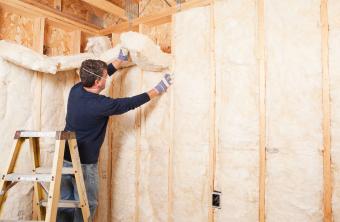
Installing insulation can cut down as much as 75 percent on heat loss in the home. Installing it as the house is being built is the easiest way to do it, but insulation can be installed any time the need arises.
Types of Insulation
Insulation comes in a variety of types and installation techniques are different for each of them. The first decision you will need to make is what type of insulation will work best for your home.
The types of insulation are:
- Rolls, Blanket, Batt
- Loose fill
- Spray fill
- Rigid board
These types of insulation can be made from different materials, such as:
- Mineral Wool (Generally found as a batt, blanket, or roll)
- Glass Wool, another name for fiberglass, made from recycled glass
- Rock Wool, which is made an igneous rock
- Slag Wool, made from steel-mill slag
- Plastic Fiber, made from recycled plastics (Often used for blown in insulation)
- Polyurethane Foams
- Natural Fibers, not widely used
Each type of insulation has strengths and weaknesses so it is important to do your research to find which is best for your home. If you plan on installing insulation yourself then be sure to read through the instructions before beginning the job.
Tips for Installing Insulation
Like anything, installing insulation is easier if you have done it before. Being able to talk to an expert may save you some time and a few headaches. Spend time talking to the salespeople at the home improvement store where you get your supplies. They may have some helpful advice.
Tools
Insulation is not too difficult to work with. The tools that you will need are:
- Tape Measure
- Utility knife
- Stapler
- Putty knife
- Insulation knife
- Straight edge
- Blower for blown in insulation
- Work gloves
- Safety glasses
- Dust mask
Tips
- Fiberglass insulation expands when you take it out of the packaging. For ease of transport, as well as storage, do not open the package of insulation until you are ready to use it.
- Fit the insulation around windows and doors to fill gaps between the frame and the opening. While the entire gap should be filled for best results, packing the filling tightly will result in loss of insulation value. Fill firmly but don't over do it.
- When you install insulation around a wire, split the insulation where it crosses the wire to surround the wire with insulation. This will help to keep air spaces from forming behind the wires.
- Always install the vapor barrier toward the living space.
- If your batt type insulation has an aluminum facing then allow about an inch of space between the facing and the wallboard. To do this just staple the insulation to the inside of the stud rather than attaching it to the edge of it.
- Leave insulation in its natural state. Don't try to compress it and don't try to fluff it up. This will interfere with the R values of the insulation and result in poor performance.
- Foam board insulation is great for basement applications because it does not absorb water or moisture.
- A vapor barrier should always be installed on basement walls first with the framing added later. This will lessen the amount of moisture that comes through the foundation walls.
Blown In Insulation
Blown in insulation is loose fill-insulation, often made with cellulose. It is one of the easiest types of insulation to install for a do-it-yourself type person. When done properly the cellulose molds around pipes and fits into unusually shaped spaces often found in old homes.In order to add blown in insulation to your home you will need to rent an insulation blowing machine. Once you do that, it is only a matter of blowing the insulation into the space.
Johns Manville has a list of instructions for adding blown in insulation to an attic.
Fiberglass Batt Insulation
One of the least expensive ways to insulate walls is to fill the stud spaces with fiberglass batt insulation. It does not take any special skills, other than a lot of patience. When you are remodeling fiberglass batt is one of the simplest ways to upgrade your wall insulation. Do a thorough job, though; gaps can reduce overall efficiency by as much as 25 percent.
The Family Handyman has tips and instructions for installing fiberglass batts. The instructions are clear and easy to understand.
Blanket and Roll Insulation
Blanket and roll insulation is useful for insulating long runs in homes. Any area that needs insulation that is longer than eight feet is a good candidate for this type of insulation.
- Unfinished walls in basements
- Crawlspaces
- Between ceiling and floor joists
Blanket insulation is installed in a similar way to the fiberglass batts. The blanket is generally held against the sill plates at the top of the wall by furring strips. Johns-Manville has an excellent tutorial on this procedure.
Insulation keeps your home quiet and energy efficient. By upgrading or installing insulation yourself you can obtain these benefits for far less money than if you hired someone to do it for you, and you can make sure that the insulation is properly installed to give you the most benefit.







